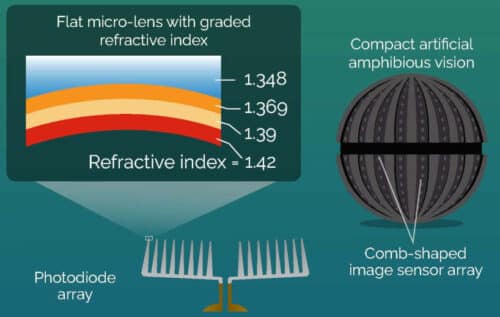Researchers recreate the Fiddler crab’s eyes in an aquatic artificial vision system with a wide field of view.
Smart cameras, object detection, crop monitoring, and self-driving automobiles are just a few of the uses for artificial vision systems. Such vision is frequently influenced by the vision of living things. For instance, terrestrial artificial vision has been influenced by human and insect vision, whereas aquatic artificial vision has been influenced by fish eyes. While the advancement is impressive, there are still significant drawbacks with present artificial visions, like their hemispherical (180°) field-of-view and inability to image both terrestrial and underwater surroundings (FOV).
A team of researchers from the United States and Korea, led by Professor Young Min Song of the Gwangju Institute of Science and Technology in Korea, have now created a cutting-edge artificial vision system with omnidirectional imaging capabilities that can operate in both aquatic and terrestrial environments to address these problems.
“Research in bio-inspired vision often results in a novel development that did not exist before. This, in turn, enables a deeper understanding of nature and ensure that the developed imaging device is both structurally and functionally effective,” says Prof. Song, explaining his motivation behind the study.
The scientists created a vision system that consists of a collection of flat microlenses with a graded refractive index profile that are combined with a flexible silicon photodiode array and put onto a spherical structure. The microlens was designed with a flat surface and a graded refractive index to minimise defocusing caused by environmental changes. Simply put, a focal point was created by forcing light rays passing through various media with various refractive indices to focus there.

The researchers conducted optical simulations and imaging demonstrations in both air and water to evaluate the system’s capabilities. The device was used for amphibious imaging when partially submerged. To their surprise, the system’s visuals were sharp and distortion-free. The researchers also demonstrated how the system had a panoramic sight field in both air and water that measured 300° horizontally and 160° vertically. The system was small and portable due to the 2 cm diameter of the spherical mount.
“Our vision system could pave the way for 360° omnidirectional cameras with applications in virtual or augmented reality or an all-weather vision for autonomous vehicles,” speculates Prof. Song excitedly.
Click here to access their paper.






